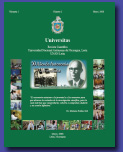Metrología Química II: Estimación de la Incertidumbre en la Medición de pH en Aguas
DOI:
https://doi.org/10.5377/universitas.v2i1.1638Palabras clave:
Metrología química, Incertidumbre en la medición de pH en aguas, Incertidumbre expandida relativa en la medición de pH, Potencial de asimetría.Resumen
El objetivo principal del presente trabajo es estimar la incertidumbre en la determinación del pH en una muestra de agua tomando en cuenta todos los parámetros experimentales que intervienen en el proceso de medición. Para evaluar la incertidumbre se siguió el procedimiento general establecido en la guía GUM ISO 1995. Se derivó el modelo matemático, donde interviene el efecto del potencial de asimetría del electrodo de vidrio utilizado. Se identificaron todas las fuentes de incertidumbres a través del diagrama causa-efecto. Se calcularon todos los componentes de las incertidumbres y se combinaron a través de la ley de propagación de la incertidumbre para obtener el valor de la incertidumbre estándar en la medición del pH en la muestra de agua (upHx). Se elaboró un diagrama de Pareto, donde se demuestra que de 7 fuentes principales de incertidumbre, solamente la repetibilidad en la lectura del potencial (Ex) de la muestra y la incertidumbre en el cálculo del pH donde el potencial es nulo (pH0) son los que influyen en la estimación de upHx, cuyo valor fue 0.05. El intervalo de confianza encontrado fue de 7.6 ± 0.11. La incertidumbre expandida fue calculada tomando como factor de cobertura el valor de t al 95% de nivel de confianza y 18 grados de libertad efectivos.
Descargas
1451
Citas
Delgado, M., Vanegas, M. y Delgado G. (2007), "Metrología Química I: Calibración de un pHmetro y control de calidad", UNIVeRSItAS, Número 1, vol 1, pag.14-23, León, Nicaragua. https://doi.org/10.5377/universitas.v1i1.1627
Westcott, C., (1978), pH Measurements, N.Y, Academic Press, p.172.
Clesceri, L., Greenberg, A. y eaton, A., (1998), Standard Methods for the examination of Water and Wastewater, N.Y., American Publishing Health Association, 20th edition, p. 2-24, 2-26.
Midgley, D. and torrance, K., (1978), Potentiometric Water Analysis, N.Y., john Wiley, p. 135, 147.
ISO/IeC 17025(eS), (2005), "Requisitos Generales para la Competencia de los Laboratorios de ensayo y de Calibración", Norma Internacional, Ginebra, Segunda edición.
ISO/IeC 17011(eS), (2004), "evaluación de la conformidad - Requisitos generales para los organismos de acreditación que realizan la acreditación de organismos de evaluación de la conformidad", Norma Internacional, Ginebra.
Bievre, P. (2006), "On quality of a measurement result", Accred. Qual. Assur, 11, 597-598. https://doi.org/10.1007/s00769-006-0208-7
Eurachem/Citac Guide, (2003), "treceability in Chemical Measurement", Guía de Referencia, 1ra. edición, UK.
Kimothi, S.K., (2000), the Uncertainty of Measurements, ASQ Quality Press, Wisconsin , pag. 391.
a) Leito, I., Strauss, L., Koort, e, y Phil, V.,(2000) Accred. Qual. Assur. 7 (2000) 242-249 https://doi.org/10.1007/s00769-002-0470-2
b) KOORt, e., (2006), "estimation of potentiomentrically measured pH, and pKa Values" (tesis doctoral), tartu University PReSS, estonia.
Aguiar R. et al., (2004), Guía técnica sobre trazabilidad e Incertidumbre en las Mediciones Analíticas que emplean la técnica de Medición de pH, CeNAM/ema, México.
BIPM, IeC, IFCC, IUPAC, OIML, (1995) Guide for to the expression of Uncertainty in Measurement (GUM), ISO, Ginebra.
Euracherm/Citac GUIDe, (2000), Quantifying Uncertainty in Analytical Chmistry, 2da edición, UK.
Philips S.D., eberthardt KR, y Parry b, (1993) "Guidelines for expressing the uncertainty of measurement results containing uncorrected bias". journal of Research of National Institute of Standards and technology, 102, 5, 577-585 https://doi.org/10.6028/jres.102.039
IZASA , (1998), "trazabilidad en la medida de pH". Industria Farmacéutica Analítica y biotecnología, 13, 49-51.
Strobel, H., (1989), Chemical Instrumentation, 3ª edición, john Wiley, NY, pág 1030.
IUPAC (1998), Compendium of Analytical Nomenclature, 3ª edición, Oxford, pag 3-11
Dean j. (1979) Lange's Handbook of chemistry, 12ª edición, McGraw Hill, N.Y.
Bates, R. G., (1963), Determination of pH, 2da. edición, john Wiley, NY. Pag 365.
Skoog, D. A., Holler, F. j. y Nieman, t. A., (2005), Análisis Instrumental, Madrid, 5ta. edición, McGraw Hill, p.650.
Riley t. y tomlinson, C. (1987), Principles of electroanalytical Methods, john Wiley, London, pág. 57.
Wodsworth, H. M., Stephens, K. y Godfrey, A. b., (2005), Métodos de Control de Calidad, México, Compañía editorial Continental, 1ra. edición, p. 359.
Mathias, O., (1999), Chemometrics, Weinhein, Alemania, Wiley-VCH, p. 186.
Descargas
Publicado
Cómo citar
Número
Sección
Licencia
Derechos de autor 2008 Universidad Nacional Autónoma de Nicaragua, León

Esta obra está bajo una licencia internacional Creative Commons Atribución-NoComercial-CompartirIgual 4.0.
Copyright © 2025 Universitas (León), Revista Cientifíca de la UNAN-León. Uiversidad Nacional Autónoma de Nicaragua, León. Dirección Académica. Departamento de Investigación. Unidad de Publicaciones y Eventos Científicos.






